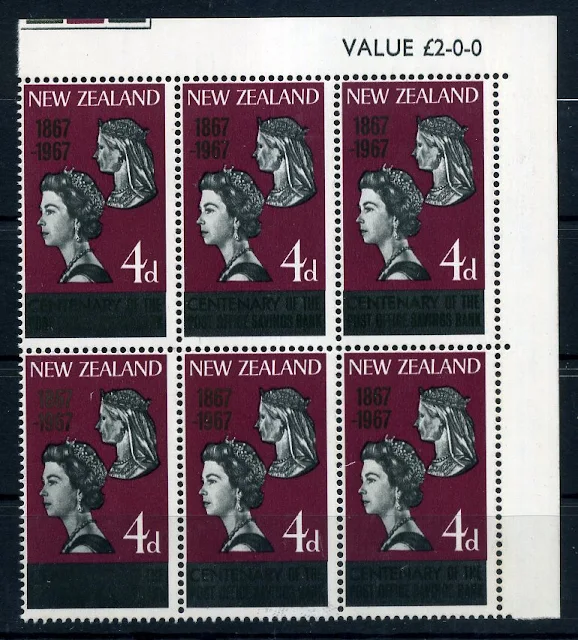1967 Post Office Savings Bank Centenary.
As commemorative stamp issues had already been produced for the centenaries of the Postal Service and Telegraph Service it was felt appropriate that a special stamp issue should be produced for the centenary of the Post Office Savings Bank in 1967.
The opening of the first Post Office Savings Bank occurred in the 1860s, the gold rush years in New Zealand. It was an important event that fostered the habit of thrift and saving among the increasingly prosperous colonists of this relatively young nation.


4d - Queens. 9d - Coins.
4d - Queen Victoria and Queen Elizabeth II Profiles.
9d - Half Sovereign and Decimal Dollar Coins.
This stamp shows the reverse side of a half-sovereign, in circulation in 1867, and the reverse side of a New Zealand dollar coin issued to commemorate the changeover to decimal currency.
First Day Cover.
A relatively simple design for this First Day Cover.
Printing Errors of this issue.
The gold colour has been omitted off both values.
Notice the black where the gold should be in each design.
Two blocks of the 4d stamp,
both showing problems with the gold.
On this top right-hand corner block of six stamps the gold has been completely omitted.
This is a very interesting selvage block of four. The gold is completely omitted on the top right stamp and partly omitted
on the top left and bottom right stamps. The stamp to the bottom left, appears to be normal.
1967 9d Coins top-left corner block of eight, with large Dr Blade flaw in silver running down left selvage.
It only slightly effects the left-hand stamps.
1967 Royal Society of New Zealand Centenary.
Founded by Sir James Hector, The Royal Society of New Zealand was constituted under the New Zealand Institute Act of 10 October 1867, for the furthering of all branches of scientific research. To mark its 100th Anniversary this set of two values was issued depicting subjects related to the society.
4c - Mount Aspiring. 8c - Sir James Hector.
4c - Mount Aspiring / To Promote Science.
This stamp depicted Mt Aspiring as a symbol of high endeavour with the Southern Cross and Aurora Australis in the background. Also featured is a vertical panel incorporating elements representing the scientific interest of the Society: geology, mining, botany, zoology and biology.
8c - Sir James Hector / To Promote Science.
This stamp depicted a portrait of Sir James Hector. Sir James Hector was an geologist and explorer who was born in Edinburgh in 1834. He came to NZ in 1862 to conduct a geological survey. In 1871 he became a member of the first senate of the University of New Zealand. In 1885 he was elected Chancellor of the University, a position he held for 18 years; and he was three times President of the Australasian Association for the Advancement of Science. Hector died in 1907.
First Day Cover.
Printing Errors of this issue.
1967 8c Royal Society Sir James Hector
with major colour shift of the Grey. Best seen in the value and as
doubling on his coat.
8c Royal Society 1967 selvage pair with 2 comb heads shifted.
Well that was what the site where I found this image said. From my knowledge of printing, it is not likely that perforation combs would come loose and move like this. Large sheets were perforated using large platens in a flat bed printing machines. The combs, the strips with pins to pierce the paper were aligned using flat spacing material. My guess is that we are looking at a trial during set up. The perforation platen would then be removed from the machine and the out of align combs would be moved by changing the spacing around. Then platen will then be locked up again ready for another trial.
Technical information - Post Office Savings.
Date of Issue:
|
3 February 1967
|
|---|---|
Designers:
|
New Zealand Post Office, Wellington
|
Printers:
|
Harrison and Sons, England
|
Stamp Size:
|
25mm x 41mm
|
Sheet Size:
|
120 stamps per sheet
|
Process:
|
Photogravure
|
Performance Gauge:
|
14 x 14.75
|
Paper Type:
|
Chalk surfaced, multiple NZ and star watermark
|
Technical information - Royal Society.
Date of Issue:
|
10 October 1967
|
|---|---|
Designers:
|
J Berry, Wellington
|
Printers:
|
Thomas De La Rue, England
|
Stamp Size:
|
24mm x 40mm
|
Sheet Size:
|
100 stamps per sheet
|
Process:
|
Delacry
|
Performance Gauge:
|
4c: 14 x 13.75; 8c: 13 x 13.75
|
Paper Type:
|
Chalk surfaced, NZ and star watermark
|
Some of the images in this post were used with permission from the illustrated catalogue of StampsNZ
You can visit their web site and On-line Catalogue at, http://stampsnz.com/










We appreciate your engagement with our content. To ensure a respectful and constructive community, please take note of the following:
- No Spam, Please: We do not tolerate spammy or promotional comments. Any such comments will be promptly removed.
- Moderation in Place: All comments are moderated to maintain a positive and inclusive environment. Please be patient, as it may take a little time for your comment to appear.
- Sign In with Google: To comment, please sign in using your Google account. This helps us maintain the integrity of our community and allows for better interaction.